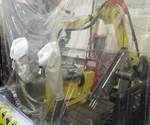Consortium Builds Ship Propeller Via Wire plus Arc Additive Manufacturing (WAAM)
The robot-driven deposition technology has been successfully applied in a propeller application for the marine industry.
A cooperative consortium has successfully applied Wire plus Arc Additive Manufacturing (WAAM) to build a large propeller for a marine application. The additively manufactured part is based on a Promarin design typically found on a Damen Stan Tug type 1606. Fabricated from a bronze alloy, the propeller measures 1,300 mm in diameter and weighs approximately 180 kg.
The propeller was produced by a consortium consisting of the Damen Shipyards Group, RAMLAB, Promarin, Autodesk and Bureau Veritas, formed to develop first-class approved marine propellers made via additive manufacturing (AM). Damen’s involvement in the project began as a result of one of its in-house student research programs. Three students from Delft Technical University were investigating the potential of WAAM technology and they introduced Damen to the other members of the consortium.
“What is quite unique about this group of five companies is that, while we have joint interests, we also have individual aims,” says Kees Custers, project engineer in Damen’s Research & Development department. “This leads to a very productive and cooperative atmosphere in what is a very exciting project.”
Developed by researches at Cranfield University, WAAM is a deposition process that uses a GTAW (TIG) fusion welding power source. The WAAM program began in 2007 with funding from the University’s Innovative Manufacturing Research Centre and 15 industry partners, with the goal of creating a high-deposition rate additive manufacturing system incorporating a fully integrated robot. The WAAM system they developed currently offers a deposition rate of 10 kg/hr. for titanium, said to be higher than that offered by laser-based powder-bed methods.
The robot-driven WAAM system operates in an inert gas environment within a flexible enclosure developed by Huntingdon Fusion Technologies that can range to 27 m3. This customizable enclosure space coupled with high deposition rates make WAAM capable of producing larger parts several meters in size, such as marine and aircraft components.
Related Content
-
How Avid Product Development Creates Efficiencies in High-Mix, Low-Volume Additive Manufacturing
Contract manufacturer Avid Product Development (a Lubrizol company) has developed strategies to streamline part production through 3D printing so its engineering team can focus on development, design, assembly and other services.
-
Formlabs Part Removal Mechanism Enables Lights-Out Production
A build platform overcoming the need for manual part removal enables automated part handling, and therefore continuous production from one build cycle to the next.
-
Combining Metal and Polymer for Better 3D Printed Tools
Applications prone to wear call for more durable tooling than 3D printed polymer alone, but full metal is not always necessary.













